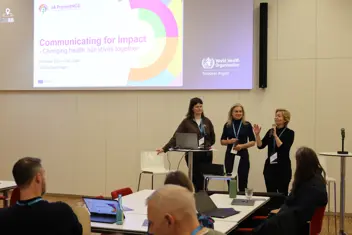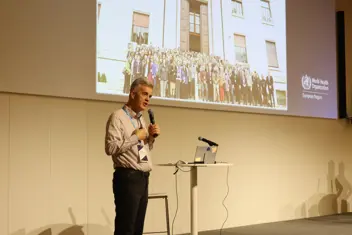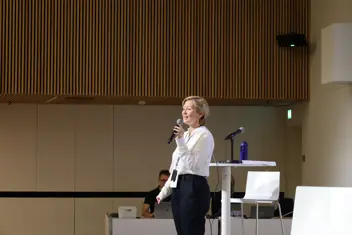It was two inspiring days in UN City, Copenhagen, where communication teams from JA PreventNCD, JACARDI, and WHO/Europe came together with a shared mission — to be big, bold, and brave in how we communicate health. With energy, optimism, and creativity, the teams explored how to strengthen trust, reframe narratives, and drive real change in the prevention of non-communicable diseases. The discussions reminded us that while our task is complex, the power of clear, positive, and collaborative communication can make a lasting difference to people’s health and wellbeing across Europe.
Over the course of the two-day programme, JA PreventNCD, JACARDI, and the WHO Regional Office for Europe co-hosted two major events at UN City: From Strategy to Action: Strengthening Communication for NCD Prevention on 9 October and Communicating for Impact: Changing Health Narratives Together on 10 October. Each session gathered communicators, policymakers, and researchers to exchange insights and practical experiences, exploring how strategic storytelling, audience engagement, and trust-building can amplify the impact of public health communication and help reframe the conversation around NCD prevention across Europe.

Sólveig Karlsdóttir, Anita Thorolvsen Munch and Aleksandra Olsen welcome people on day 1.
From Strategy to Action
The first day, led by Sólveig Karlsdóttir and Anita Thorolvsen Munch from the Directorates of Health in Iceland and Norway, focused on translating strategy into practice. Participants reviewed national communication approaches, exchanged lessons learned, and discussed how to align and strengthen collaboration between European joint actions working on NCD prevention.
Sólveig Karlsdóttir, who leads communication in the JA PreventNCD highlighted the collective ambition and potential of the joint efforts:
“Communication is at powerful tool we have in the fight against non-communicable diseases. The industries behind tobacco, alcohol, unhealthy diets, and physical inactivity invest heavily to shape the public conversation in their favour. To protect and promote health, we need to ensure that evidence-based messages and trustworthy information reach people first. Building and maintaining trust in public health is at the heart of what we do.”
Interactive sessions encouraged participants to think creatively about how to turn strategies into action. The joint campaign development workshop invited participants to identify shared target audiences, refine key messages, and begin shaping concepts for the upcoming cross-European campaign under JA PreventNCD.
The day also featured a panel on stakeholder engagement, where communication experts from JA PreventNCD and JACARDI shared experiences from national initiatives. Slovenia’s example of involving stakeholders early in the process stood out as an effective approach to creating long-term impact. The discussions highlighted that consistent messaging, shared learning, and collaboration across borders are essential for changing behaviours and social norms.

Albert Aszalos, communication lead for JACARDI
Communicating for Impact
The second day, moderated by Aleksandra Olsen, Communication Officer at WHO/Europe, began with opening remarks from Dr Gundo Weiler, Director of Prevention and Health Promotion at WHO/Europe, alongside representatives from JA PreventNCD and JACARDI.
Albert Aszalos, communication lead for JACARDI, underlined the importance of elevating the visibility of the work being done through the Joint Actions:
“To change health outcomes, we first need to change the conversation. The results of our projects should not stay within expert circles. They need to resonate with the public and policymakers alike so that prevention becomes a natural part of how we think about health. Together, we can help Europe move toward a healthier future.”
One of the morning’s highlights was the keynote presentation by Henriette Skadinn, Executive Client Director at WPP Media and Mindshare Global, titled Capturing the Gaze: Media Strategies in the Attention Economy across Europe. Henriette explored what it takes to succeed in a competitive media environment and how differences across European countries and regions influence communication opportunities. Her presentation offered a timely reminder that understanding media habits and audience dynamics is essential to ensure that public health messages cut through the noise.
Unmasking Influence: Confronting Commercial Determinants of Health
Participants also attended a screening of “Unmasking Influence”, a new documentary film that explores how commercial organisations shape public perception and policy around health. The screening set the stage for a deeper conversation about the commercial determinants of health and how communicators can counter misinformation and harmful marketing practices.
Following the film, thematic sessions led by WHO and project experts explored the four key risk factors driving NCDs:
- Alcohol: presented by Aleksandra Olsen (WHO) and Niamh Fitzgerald (Sterling University)
- Tobacco: Rodica Munteanu and Angela Ciobanu (WHO)
- Physical activity: Rachel Altmann (BeHive Consulting) and Igor Kryuchkov (WHO)
- Healthy eating: Nora Stommer (JACARDI)
- Trust in knowledge: Live Bøe Johannessen (JA PreventNCD)
These discussions focused on reframing prevention narratives, using positive and inclusive messaging, and ensuring that public health communication remains evidence-based and trustworthy in an era of constant digital influence.
From Exposure to Action
A panel on “From Exposure to Action” gathered experts May van Schalwyk and Mark Pettigrew from the London School of Hygiene and Tropical Medicine, Angela Ciobanu (WHO), Karina Mocanu, Rafn Magnus Jonsson, and Margarida Santos, a general practitioner from Portugal. They explored how to communicate effectively on topics influenced by strong commercial interests and misinformation.
The group identified three key priorities for communicators:
- Listen first. Use social listening and user insights to understand audiences and the environments they live in.
- Test and adapt. Build and refine messages through audience testing and feedback.
- Evaluate and evolve. Learn from campaign performance to improve reach, relevance, and trust.
The day concluded with a campaign creation workshop, where participants applied the insights gained to develop actionable next steps for the joint campaign being prepared under JA PreventNCD and JACARDI.

Aleksandra Olsen welcomes guests on day 2
A Collective Voice for Health
Reflecting on the two-day event, Aleksandra Olsen noted:
“It is inspiring to see these two Joint Actions putting communication at the center of NCD prevention. The WHO is proud to support this collaboration because how we communicate health information determines whether it leads to understanding, engagement, and change.”
The events in Copenhagen marked an important milestone in Europe’s collective effort to strengthen public health communication. By combining the knowledge, creativity, and experience of multiple European initiatives, the network is building the foundation for a more coordinated and impactful approach to NCD prevention.
Together, JA PreventNCD, JACARDI, and WHO/Europe are showing that effective communication is not only about delivering information but about shaping trust, building momentum, and making the healthy choice the easy choice for people and their communities.
